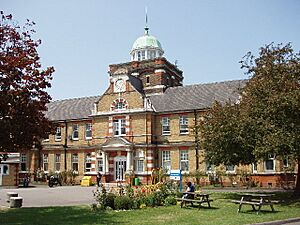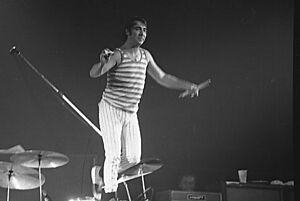Keith Moon facts for kids
Quick facts for kids
Keith Moon
|
|
|---|---|
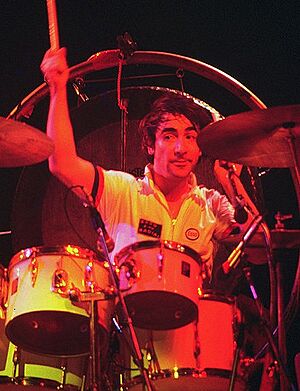
Moon in 1975
|
|
| Born |
Keith John Moon
23 August 1946 |
| Died | 7 September 1978 (aged 32) Mayfair, London, England
|
| Resting place | Golders Green Crematorium, London, England |
| Occupation |
Musician
|
| Spouse(s) |
Kim Kerrigan
(m. 1966; div. 1975) |
| Partner(s) | Annette Walter-Lax (1975–1978) |
| Children | 1 |
| Musical career | |
| Genres | |
| Instruments |
|
| Years active | 1962–1978 |
Keith John Moon (born August 23, 1946 – died September 7, 1978) was a famous English musician. He was the drummer for the rock band The Who. Many people think he was one of the greatest drummers in rock music history. He was known for his special way of playing and his wild, energetic personality.
Keith grew up in Wembley, England. He started playing drums in the early 1960s. After playing with a local band called the Beachcombers, he joined The Who in 1964. This was just before they recorded their first song. Keith was famous for his drumming style. He used a lot of tom-toms, loud cymbal crashes, and exciting drum fills.
Over time, his drum kit got bigger and bigger. He was one of the first rock drummers to use two bass drums in his setup. Keith sometimes worked with other musicians and even acted in movies. But playing in The Who was always his main job. He stayed with the band until he died. Besides his drumming talent, Keith was known for smashing his drum kit on stage. He also enjoyed touring and spending time with friends. He got bored when The Who wasn't busy. His 21st birthday party in Flint, Michigan, is a famous example of how wild rock bands could be.
In the 1970s, Keith faced some tough times. His marriage ended, which was very hard for him. He was often called "Moon the Loon" because of his funny and sometimes wild actions. Keith moved back to London from Los Angeles in 1978. He passed away that September.
Keith Moon's drumming is still praised by music fans and musicians today. He was added to the Modern Drummer Hall of Fame in 1982. In 2011, a Rolling Stone magazine poll voted him the second-greatest drummer ever. He was also inducted into the Rock and Roll Hall of Fame in 1990 as a member of The Who.
Contents
Early Life
Keith John Moon was born on August 23, 1946. His parents were Alfred Charles (Alf) and Kathleen Winifred (Kit) Moon. He was born at Central Middlesex Hospital in northwest London. Keith grew up in Wembley. As a boy, Keith was very energetic and had a big imagination. He especially loved music and a radio comedy show called The Goon Show.
Keith went to Alperton Secondary Modern School. He failed his eleven plus exam, which meant he couldn't go to a grammar school. His music teacher once wrote that Keith "has great ability, but must guard against a tendency to show off."
When he was twelve, Keith joined his local Sea Cadet Corps band. He tried to play the bugle, but it was too hard. So, he decided to play the drums instead. Keith loved playing jokes and doing science experiments at home. He especially liked making explosions. After school, Keith often went to Macari's Music Studio. He would practice drums there and learn his basic skills. He left school around Easter in 1961, when he was 14. Keith then went to Harrow Technical College. This led to a job fixing radios, which helped him buy his first drum kit.
Music Career
Starting Out
Keith took drum lessons from Screaming Lord Sutch's drummer, Carlo Little. He paid ten shillings for each lesson. Keith's early drumming style was influenced by jazz, American surf music, and rhythm and blues. He especially liked the famous Los Angeles studio drummer Hal Blaine. His favorite musicians were jazz artists, like Gene Krupa, whose flashy style Keith later copied. He also admired Elvis Presley's drummer DJ Fontana, The Shadows' drummer Tony Meehan, and the Pretty Things' Viv Prince. Keith also enjoyed singing, especially Motown music. He really looked up to the Beach Boys. Roger Daltrey later said that Keith would have left The Who to play for the California band if he had the chance.
During this time, Keith joined his first serious band, the Escorts. In December 1962, he joined the Beachcombers. This was a band in London that played cover songs by groups like The Shadows. Keith started adding theatrical tricks to his performances. He even used a starter pistol to "shoot" the lead singer. The Beachcombers all had other jobs. Keith, who worked selling plaster, was the most eager to become a professional musician. In April 1964, when he was 17, he tried out for The Who. He was replacing their old drummer, Doug Sandom.
Joining The Who
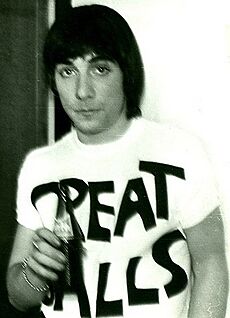
There's a well-known story about how Keith joined The Who. He showed up at a show after their old drummer left. A temporary drummer was playing that night. Keith, dressed in bright orange clothes and with his hair dyed ginger, told the band he could play better. He played during the second half of the show. He almost destroyed the drum kit while playing!
Keith later told the story: "They said go ahead. I got behind this other guy's drums and played one song—'Road Runner.' I'd had some drinks to be brave. When I got on stage, I went arrgggGhhhh on the drums. I broke the bass drum pedal and two drum skins, then I got off. I thought that was it. I was so scared. Afterwards, I was sitting at the bar and Pete came over. He said: 'You ... come 'ere.' I said, very calmly: 'Yes, yes?' And Roger, who spoke for the band then, said: 'What are you doing next Monday?' I said: 'Nothing.' I was working during the day, selling plaster. He said: 'You'll have to quit work ... there's this gig on Monday. If you want to come, we'll pick you up in the van.' I said: 'Right.' And that was it." Keith later joked that he was never officially asked to join The Who permanently. When Ringo Starr asked him how he joined, Keith said he had "just been filling in for the last fifteen years."
Keith's arrival changed the band. The old drummer, Doug Sandom, used to calm down arguments between Roger Daltrey and Pete Townshend. But with Keith's personality, all four members often argued. "We used to fight regularly," Keith remembered. "John [Entwistle] and I used to have fights—it wasn't very serious, just quick arguments." Keith also argued with Roger and Pete. "We really have nothing in common except music," he said. Even though Pete Townshend called him "completely different," they had a good connection early on. They enjoyed playing jokes and making up funny scenes. Keith's drumming style changed the band's music. At first, John Entwistle found Keith's unusual timing difficult. But it helped create The Who's unique sound.
Keith especially loved touring. It was his only chance to spend time with his bandmates. He was often restless and bored when they weren't playing live. This led to his famous antics, earning him the nickname "Moon the Loon."
Drumming Style
Keith's drumming style was unique to his bandmates. Sometimes they found his unusual playing frustrating. John Entwistle said that Keith often played faster or slower depending on his mood. "He wouldn't play across his kit," John added. "He'd play zig-zag. That's why he had two sets of tom-toms. He'd move his arms forward like a skier." Roger Daltrey said that Keith "just naturally put drum fills in places that other people would never have thought of."
Some early critics questioned if Keith could keep time well. But The Who's producer, Jon Astley, said, "You didn't think he was keeping time, but he was." On the album Who's Next, Keith started to play with more discipline in the studio. Many people think the drumming on this album is the best of Keith's career.
Unlike other drummers like Ginger Baker and John Bonham, Keith hated drum solos. He refused to play them in concerts. At a show in 1974, Pete Townshend and John Entwistle stopped playing to hear Keith's drum solo. Keith played for a short time and then stopped, shouting, "Drum solos are boring!"
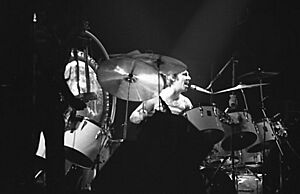
Keith also wanted to sing lead vocals on some songs. While the other three band members sang most of the songs, Keith would try to sing backup. He also made funny comments when introducing songs. The band sometimes banned him from the studio when they were recording vocals. This led to a game where Keith would try to sneak in and join the singing. At the end of the song "Happy Jack", you can hear Pete Townshend saying, "I saw ya!" to Keith. Keith's interest in surf music led him to sing lead vocals on early songs like "Bucket T" and "Barbara Ann". His singing on "Bell Boy" from the album Quadrophenia was a character performance.
Keith wrote some songs for The Who. These include "I Need You" and the instrumental "Cobwebs and Strange." He also co-wrote "In The City" with John Entwistle. Keith helped create "The Ox" with Pete Townshend, John Entwistle, and keyboard player Nicky Hopkins. The song "Tommy's Holiday Camp" was credited to Keith because he came up with the idea.
Wild Stage Antics
At an early show, Pete Townshend accidentally broke his guitar and then smashed it. When the audience wanted him to do it again, Keith kicked over his drum kit. After that, their live shows often ended with the band destroying their equipment. Keith started kicking over his drums because he felt the audience wasn't excited enough. Pete Townshend later said, "A set of drums cost about $300, and after every show he'd just go bang, bang, bang and then kick the whole thing over."
In 1967, during their appearance on The Smothers Brothers Comedy Hour, Keith paid a stagehand to put gunpowder in one of his bass drums. The stagehand used about ten times the normal amount! During the end of "My Generation," Keith set off the charge. The explosion was so strong it singed Pete Townshend's hair. A piece of cymbal even got stuck in Keith's arm. A video of this moment became the opening scene for the film The Kids Are Alright.
Even though Keith was known for kicking over his drum kit, it was often done carefully. The kit rarely needed big repairs. However, drum stands and foot pedals were replaced often. Keith "would go through them like a knife through butter."
Other Music Projects
While Keith usually said he only wanted to work with The Who, he did join other music projects. In 1966, he worked with Yardbirds guitarist Jeff Beck, pianist Nicky Hopkins, and future Led Zeppelin members Jimmy Page and John Paul Jones. They made the instrumental song "Beck's Bolero". Keith also played timpani on another song, "Ol' Man River". He was credited on the album as "You Know Who."
Keith may have inspired the name for Led Zeppelin. In 1966, he thought about leaving The Who. He talked with John Entwistle and Jimmy Page about forming a new supergroup. Keith (or John Entwistle) joked that one idea had gone down like a "lead zeppelin" (like a "lead balloon"). Even though this supergroup never formed, Jimmy Page remembered the phrase and later used it for his new band.
The Beatles became friends with Keith, and they sometimes worked together. In 1967, he sang backing vocals on "All You Need Is Love". In 1969, Keith joined John Lennon's Plastic Ono Band for a live concert. This was a charity show for UNICEF.
Keith's friendship with John Entwistle led him to appear on Smash Your Head Against the Wall. This was John Entwistle's first solo album. Keith did not play drums on this album; he played percussion.
Keith started doing solo work when he moved to Los Angeles in the mid-1970s. In 1974, he released a solo song that covered the Beach Boys' "Don't Worry, Baby". The next year, he released his only solo album, called Two Sides of the Moon. Keith sang on the album, but he only played drums on three songs. Other drummers, like Ringo Starr, played most of the drums. Critics did not like the album very much.
Acting Roles
In a 2007 documentary about The Who, Roger Daltrey and Pete Townshend talked about Keith's talent for acting. They remembered that he dreamed of leaving music to become a Hollywood actor. However, Roger didn't think Keith had the patience needed for acting. The Who's manager, Bill Curbishley, agreed that Keith "wasn't disciplined enough to actually turn up or commit to doing the stuff."
Still, Keith got several acting jobs. His first role was a small appearance in Frank Zappa's film 200 Motels in 1971. He played a nun. Keith's next film role was J.D. Clover, a drummer in the film That'll Be the Day (1973). He played this role again in the 1974 sequel, Stardust. He also played Uncle Ernie in Ken Russell's 1975 film Tommy. Keith's last movie was Sextette in 1978.
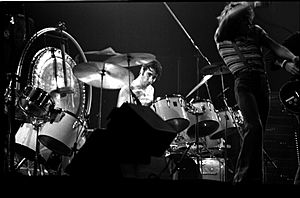
Personal Life
Family Life
Keith Moon's first serious relationship was with Kim Kerrigan. They started dating in January 1965. By the end of that year, Kim found out she was pregnant. She moved into Keith's family home in Wembley. Keith and Kim got married on March 17, 1966. Their daughter, Amanda, was born on July 12. Their marriage and child were kept secret from the public until 1968. Keith loved Amanda very much. But because he was often away on tour and loved playing jokes, their relationship was sometimes difficult when she was very young. Kim said, "He had no idea how to be a father. He was too much of a child himself."
From 1971 to 1975, Keith owned a home called Tara in Chertsey. He lived there with his wife and daughter. The Moons often hosted big parties at their home. They also owned many cars.
In 1973, Kim felt that she couldn't change Keith's behavior. She left him and took Amanda with her. She filed for divorce in 1975. Kim later married Faces keyboard player Ian McLagan. Some people believe Keith never truly got over losing his family. Keith would call them often. Kim Kerrigan passed away in a car accident in Austin, Texas, in 2006.
Financial Habits
The Who's early stage shows involved smashing instruments. Also, Keith loved damaging hotel rooms. Because of this, the band was in debt for much of the 1960s. Even when the band became more financially stable, Keith continued to spend a lot of money. He bought many cars and gadgets. His spending habits sometimes put him close to bankruptcy.
Death
Keith Moon was found dead in his flat at 9 Curzon Place (now Curzon Square), Shepherd Market, Mayfair, London. He was cremated on September 13, 1978, at Golders Green Crematorium in London. His ashes were scattered in its Gardens of Remembrance.
Legacy
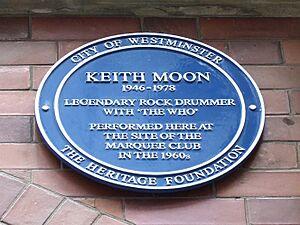
Many critics have praised Keith Moon's drumming. Author Nick Talevski called him "the greatest drummer in rock." He added that Keith "was to the drums what Jimi Hendrix was to the guitar." Holly George-Warren, an editor for The Rock and Roll Hall of Fame, said that with Keith's death, "rock arguably lost its single greatest drummer."
Several rock drummers, including Neil Peart, have said Keith Moon influenced them. The Jam honored Keith Moon on a song released about a month after his death. Animal, one of Jim Henson's Muppet characters, may have been based on Keith Moon. They have similar hair, eyebrows, personality, and drumming styles.
Ray Davies of The Kinks praised Keith's drumming when The Kinks were inducted into the Rock and Roll Hall of Fame in 1990. He said, "... Keith Moon changed the sound of drumming."
Clem Burke of Blondie said, "Early on all I cared about was Keith Moon and The Who. When I was about eleven or twelve, my favorite part of drum lessons was the last ten minutes, when I'd get to sit at the drumset and play along to my favorite record. I'd bring in 'My Generation'. At the end of the song, the drums go nuts. 'My Generation' was a turning point for me."
In 1998, Tony Fletcher wrote a book about Keith Moon called Dear Boy: The Life of Keith Moon. The phrase "Dear Boy" was a common saying of Keith's. Q Magazine called the book "horrific and terrific reading."
Discography
- Solo albums
- Two Sides of the Moon (1975)
Other appearances
- "When I'm Sixty-Four" for All This and World War II (1976)
See also
 In Spanish: Keith Moon para niños
In Spanish: Keith Moon para niños


